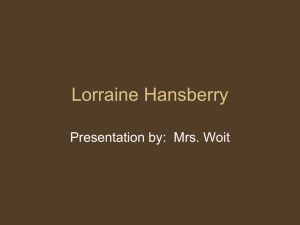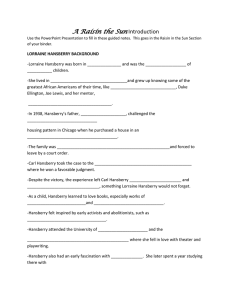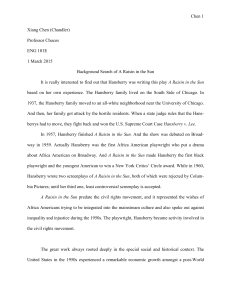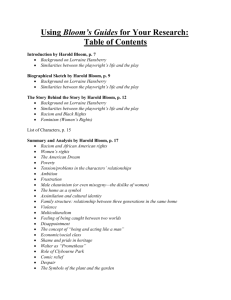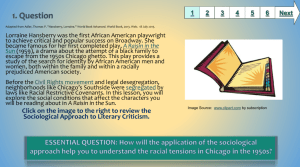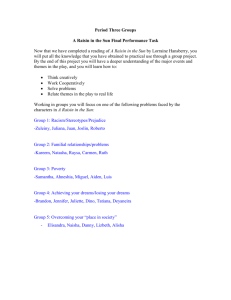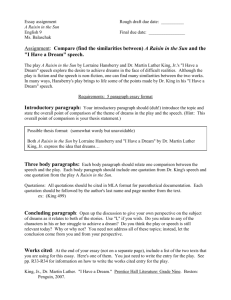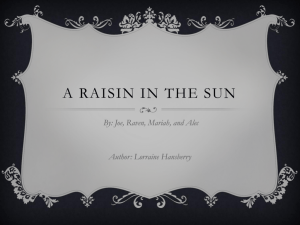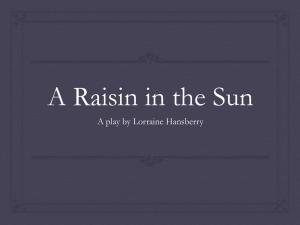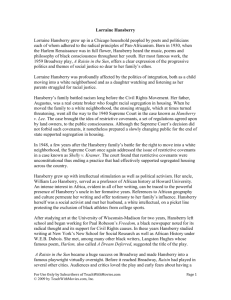A Raisin in the Sun PowerPoint Presentation
advertisement
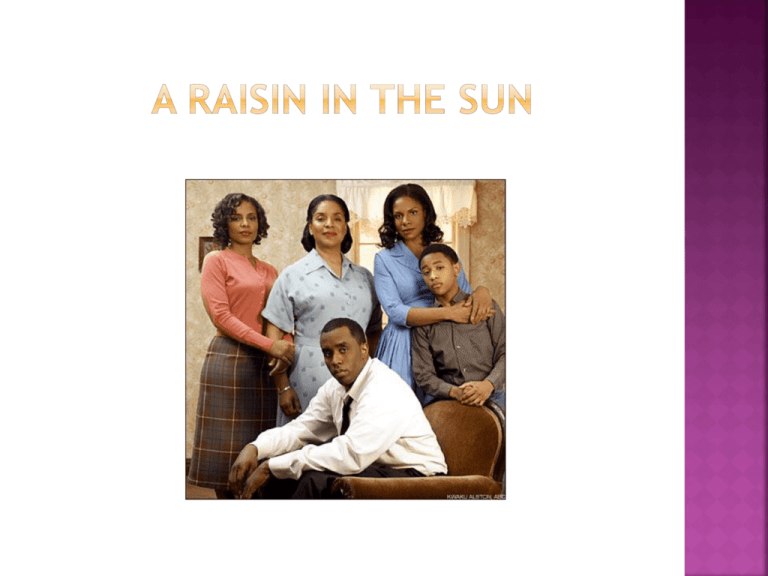
Lorraine Hansberry Lorraine Hansberry was born on May 19, 1930, and she was the youngest of four children. She enjoyed a comfortable middle class existence. She lived in South Side Chicago and grew up knowing some of the greatest African Americans of her time, like Langston Hughes, Duke Ellington, Joe Lewis, and her mentor, W.E.B. Du Bois. In 1938, Hansberry’s father, Carl, challenged the segregated housing pattern in Chicago when he purchased a house in an allwhite neighborhood. The family was threatened by a white mob and forced to leave by a court order. Carl Hansberry took the case to the Supreme Court where he won a favorable judgment in 1940 (Hansberry vs Lee). Despite the victory, the experience left Carl Hansberry bitter and disillusioned, something Lorraine Hansberry would not forget. Hansberry attended the University of Wisconsin, but left after becoming dissatisfied with the curriculum. She moved to New York and became a reporter for the radical black newspaper, Freedom. Eventually she attended the Art Institute of New York where she fell in love with theater and playwriting. As a child, Hansberry learned to love books, especially works of history and biography. Hansberry felt inspired by early activists and abolitionists, such as Frederick Douglass. Hansberry also had an early fascination with Africa. She later spent a year studying there with mentor, writer and activist W.E.B. Du bois. Another literary influence and family friend was Langston Hughes. Hansberry used a line from Hughes’s poem “Harlem” for the title of her play, A Raisin in the Sun. 1957, A Raisin in the Sun was completed and gained critical attention, not only for its content, but also for the fact that it was written by a young African American woman. In After successful runs in Philadelphia, Chicago, and New York, A Raisin in the Sun opened on Broadway on March 11, 1959, and critics raved. Hansberry is the first African American woman to have her play produced on Broadway, running for Hansberry’s play crossed social lines with powerful grace, appealing to critics, activists, artists and theatergoers. It shed more light on the civil rights movement. The play won the New York Drama Critics Award that year, a first for any African American. Hansberry wrote several other plays, including The Sign in Sidney Brustein’s Window, and Les Blanc. In 1965, Lorraine Hansberry died an early death from pancreatic cancer. Although her life and career were cut short, an informal autobiography by her ex-husband was put together. It was called To Be Young, Gifted and Black. It is a tribute to Hansberry’s literary, social and personal vision. play A Raisin in the Sun is set during the 1950’s. This was a pivotal time during the civil rights movement and changes in history. During this time period, it was legal to discriminate against people based on race or sex, in terms of employment, education, and public accommodations. The Many African Americans continued to move to northern cities, from the South. Chicago was one of the cities that grew most from southern black immigration. Between 1940 and 1950, the number of African Americans living in Chicago grew by 80%. The number of whites Many of the African-Americans living in Chicago were living in run-down neighborhoods which became all-black public housing projects. Most units were overcrowded and shared bathroom facilities between multiple families. Jobs were increasingly hard to find for both black men and women after WWII. Many women worked as domestic help and the men were working in plants. Brown v. Board of Education outlawed segregated public schools; however, it was left to local officials to decide when they’d like to start desegregating. 1955-1956-Montgomery Bus Boycott Congressmen from Confederate States called on their states to refuse to comply with Brown v. Board. President Eisenhower also opposed Brown v. Board. The governor of Arkansas refused to let nine black students enter a local high school. The U.S. Army was called to escort and protect the nine students. 1957-Martin Luther King formed the Southern Christian Leadership Conference. A recent widow, and years of hard work are catching up with her. She is religious, compassionate, and strongwilled. She worries about her family and wrestles with decisions about Mama’s thirtyfive-year-old son, works as a chauffeur but dreams of owning his own business. He neglects his marriage, drinks to excess and betrays his mother. Walter’s wife and the mother of their son, Travis She is desperate to see her family in a home of their own. Ruth is torn between her disgust with Walter’s present behavior and her love for the man he once was. Mama’s collegeage daughter, dreams of becoming a doctor’ but pursues other interests as well. She is attracted to both George Murchison and Joseph Asagai. 10 year old son of Ruth and Walter who plays the adults against each other. George MurchisonCollege student and the son of a wealthy businessman which separates him from the Youngers. Joseph Asagai-A politically active college student from Nigeria. Neighbor who tells family what will happen if they move into a white neighborhood. Spokesman for the white neighborhood who provides a business proposal for the Youngers. friends of Walter The play’s introduction asks, “What happens to a dream deferred?” That establishes the major theme. For the most part, the dreams of the major characters have been put on hold for a long time, but, ironically, when the chance for their dreams to come true does arrive, it creates conflict. Ultimately the characters do find out that dreams can come true, but not always with ease. The Power of Prejudice-Set before the rise of the civil rights movement, A Raisin in the Sun reveals a social undercurrent of racial tension. The Youngers know discrimination; in large part it is the reason their dreams have been deferred. Prejudice in an all-white community helps drive the play to its climax, and at the play’s resolution the Youngers seem likely to face prejudice again. Years of “doing without” have taken their toll on the Youngers, but the insurance money seems to be the key to victory. The family also accomplishes a moral victory at the end that empowers the entire family. Sunlight represents goodness and darkness represents evil. The sun nourishes and allows everything to grow and develop. All that darkness nourishes is dark thoughts; plants and people wither in darkness. Symbolizes her perpetual hope for a better life. By constantly caring for the plant, however feeble it becomes, she shows the audience that she is keeping her hope alive. When Beneatha cuts her straight hair, she is rejecting the social norms of the time. For everyone in the play, money is the symbol of their dreams. All of them believe that money will be the key to their dreams coming true. Symbolizes the discrepancy between the Younger’s poor lives versus George’s privileged life. Rich blacks worked very hard to separate themselves from poor blacks as represented by his dress. Symbolizes African heritage and the fight for freedom from colonial rule and their importance to Beneatha to find her roots.
